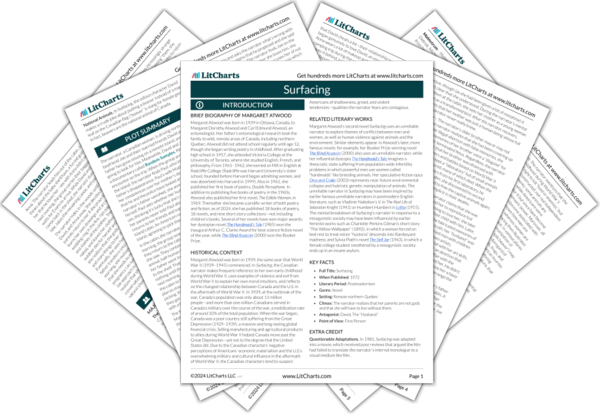Surfacing suggests that civilization rests on a series of unequal social binaries—male and female, mind and body, human and animal, and ally and enemy, for example—that encourage violence and that do not necessarily exist in nature. The narrator mentions that she learned in her Canadian childhood during World War II (1939–1945) that it was all right to kill “food or enemies,” but these categories are socially constructed, not real independent of human prejudices and judgments: some animals are considered food but not others, while Americans were Canadians’ allies during World War II but since have become threatening due to their global hegemonic power. Moreover, all the “lesser” terms in a binary tend to become associated with one another: for example, the novel shows how men are associated with humanity and intellect, whereas women are associated with animals and bodies. Surfacing then illustrates how these associations may lead to violence: in various places the narrative suggests that the erotic dehumanization of women (e.g. referring to female genitalia as “split beaver”) may lead to inequality and sexualized violence; the disregard of animal life leads to human brutality against birds, frogs, and fish; and the Canadian characters’ hatred of American tourists leads to fantasies of war and death. In this way, Surfacing indicates that it is civilization and its binaries, not nature, that encourages violence.
Binaries and Violence ThemeTracker

Binaries and Violence Quotes in Surfacing
From the side he’s like the buffalo on the U.S. nickel, shaggy and blunt-snouted, with small clenched eyes and the defiant but insane look of a species once dominant, now threatened with extinction.
What he means is that a man should be handling this; Joe will do as a stand-in. My status is a problem, they obviously think I’m married. But I’m safe, I’m wearing my wedding ring, I never threw it out, it’s useful for landladies.
Below me in the water there’s a leech, the good kind with red dots on the back, undulating along like a streamer held at one end and shaken. The bad kind is mottled gray and yellow. It was my brother who made up these moral distinctions, at some point he became obsessed with them, he must have picked them up from the war. There had to be a good kind and a bad kind of everything.
I recall the feeling, puzzled, baffled, when I found out some words were dirty and the rest were clean. The bad ones in French were the religious ones, the worst ones in any language were what they were most afraid of and in English it was the body, that was even scarier than God.
For a while I was going to be a real artist; he thought that was cute but misguided, he said I should study something I would be able to use because there has [sic] never been any important women artists. That was before we were married and I still listened to what he said, so I went into Design and did fabric patterns.
Their only function is to uphold Joe’s unvoiced claim to superior artistic seriousness: every time I sell a poster design or get a new commission he mangles another pot.
The trouble is all in the knob at the top of our bodies. I’m not against the body or the head either: only the neck, which creates the illusion that they are separate […] if the head is detached from the body both of them will die.
Love without fear, sex without risk, that’s what they wanted to be true; and they almost did it, I thought, they almost pulled it off, but as in magicians’ tricks or burglaries half-success is failure and we’re back to the other things.
I had the proof now, indisputable, of sanity and therefore of death.
Why had they strung it up like a lynch victim, why didn’t they just throw it away like the trash? To prove they could do it, they had the power to kill.
A part of the body, a dead animal. I wondered what part of them the heron was, that they needed so much to kill it.
Anything we could do to the animals we could do to each other: we practiced on them first.
“You’ll go in beside the dead bird[.]”
He said it wasn’t a person, only an animal; I should have seen that was no different; it was hiding in me as if in a burrow and instead of granting it sanctuary I let them catch it. I could have said No but I didn’t; that made me one of them too, a killer.
















